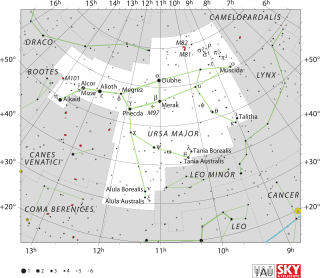Sigma2 Ursae Majoris
 | |
| Observation data Epoch J2000 Equinox J2000 | |
|---|---|
| Constellation | Ursa Major |
| σ2 UMa A | |
| Right ascension | 09h 10m 23.538s[1] |
| Declination | +67° 08′ 02.44″[1] |
| Apparent magnitude (V) | +4.813[1] |
| σ2 UMa B | |
| Right ascension | 09h 10m 23.508s[1] |
| Declination | +67° 08′ 06.58″[1] |
| Apparent magnitude (V) | +10.26[1] |
| Characteristics | |
| Spectral type | F6IV-V / K2V[2] |
| U−B color index | +0.01[3] |
| B−V color index | +0.48[3] |
| Variable type | Suspected[4] |
| Astrometry | |
| σ2 UMa A | |
| Radial velocity (Rv) | −2.92 ± 0.12[5] km/s |
| Proper motion (μ) | RA: 7.1[1] mas/yr Dec.: −95.1[1] mas/yr |
| Parallax (π) | 49.07 ± 0.37[6] mas |
| Distance | 66.5 ± 0.5 ly (20.4 ± 0.2 pc) |
| Absolute bolometric magnitude (Mbol) | 3.18[7] |
| σ2 UMa B | |
| Proper motion (μ) | RA: 4.1[1] mas/yr Dec.: −30.0[1] mas/yr |
| Absolute magnitude (MV) | 7.16[7] |
| Orbit[8] | |
| Period (P) | 970 ± 118 yr |
| Semi-major axis (a) | 5.80 ± 0.14″ |
| Eccentricity (e) | 0.801 ± 0.017 |
| Inclination (i) | 145.4 ± 1.5° |
| Longitude of the node (Ω) | 102.1 ± 1.9° |
| Periastron epoch (T) | B 1917.39 ± 0.12 |
| Argument of periastron (ω) (secondary) | 332.4 ± 1.9° |
| Details[7] | |
| σ2 UMa A | |
| Mass | 1.31 M☉ |
| Radius | 1.75 ± 0.07 R☉ |
| Surface gravity (log g) | 4.00 ± 0.10 cgs |
| Temperature | 6276 ± 80 K |
| Metallicity [Fe/H] | −0.03 ± 0.07 dex |
| Rotational velocity (v sin i) | 4.1 ± 0.8 km/s |
| σ2 UMa B | |
| Mass | ~0.73 M☉ |
| Temperature | ~4600 K |
| Other designations | |
| σ2 UMa A: TYC 4141-1496-1 | |
| σ2 UMa B: TYC 4141-1496-2 | |
| Database references | |
| SIMBAD | AB |
| A | |
| B | |
Sigma2 Ursae Majoris (σ2 Ursae Majoris, σ2 UMa) is a binary star in the constellation of Ursa Major. Parallax measurements made by the Hipparcos spacecraft put it at a distance of about 66.5 light years (20.4 parsecs) from Earth, making this a fairly nearby system. The primary component has an apparent magnitude of about 4.8,[1] meaning it can be seen with the naked eye (see Bortle scale).
This is a visual binary, meaning that the two components can be resolved, and the orbit is derived from the positions of the two stars. The primary component Sigma2 Ursae Majoris A, is a white-colored F-type subgiant. Its radius is about 1.75 times that of the Sun, and it is 31% more massive.[7] The companion is an orange K-type main-sequence star that is much fainter. The two stars are separated about 4 arcseconds away, and because of their slow orbital motion the orbit is poorly known: estimates of the orbital period range from 970 years[8] to over 1,500 years.[9] There is a third component, designated Sigma2 Ursae Majoris C. Located 205 arcseconds from the primary, it is thought to be a line-of-sight coincidence, and is not related to the system.
Naming
In Chinese, 三師 (Sān Shī), meaning Three Top Instructors, refers to an asterism consisting of σ2 Ursae Majoris and ρ Ursae Majoris. Consequently, σ2 Ursae Majoris itself is known as 三師三 (Sān Shī sān, English: the Third Star of Three Top Instructors.).[10]
References
- 1 2 3 4 5 6 7 8 9 10 11 Høg, E.; et al. (2000). "The Tycho-2 catalogue of the 2.5 million brightest stars". Astronomy and Astrophysics. 355: L27–L30. Bibcode:2000A&A...355L..27H.
- ↑ Edwards, T. W. (1976). "MK classification for visual binary components". Astronomical Journal. 81: 245–249. Bibcode:1976AJ.....81..245E. doi:10.1086/111879.
- 1 2 Mermilliod, J.-C. (1986). "Compilation of Eggen's UBV data, transformed to UBV (unpublished)". Bibcode:1986EgUBV........0M.
- 1 2 "* sig02 UMa". SIMBAD. Centre de données astronomiques de Strasbourg. Retrieved 27 March 2017.
- ↑ de Medeiros, J. R.; Mayor, M. (1999). "A catalog of rotational and radial velocities for evolved stars". Astronomy and Astrophysics Supplement. 139: 433–460. arXiv:astro-ph/0608248. Bibcode:1999A&AS..139..433D. doi:10.1051/aas:1999401.
- ↑ van Leeuwen, F.; et al. (2007). "Validation of the new Hipparcos reduction". Astronomy and Astrophysics. 474 (2): 653–664. arXiv:0708.1752. Bibcode:2007A&A...474..653V. doi:10.1051/0004-6361:20078357.
- 1 2 3 4 Fuhrmann, Klaus (2008). "Nearby stars of the Galactic disc and halo - IV". Monthly Notices of the Royal Astronomical Society. 384 (1): 173–224. Bibcode:2008MNRAS.384..173F. doi:10.1111/j.1365-2966.2007.12671.x.
- 1 2 "Sixth Catalog of Orbits of Visual Binary Stars". United States Naval Observatory.
- ↑ Shklovskii, I. S.; Wenzel, W. (1980). "Book-Review - Stars Their Birth Life and Death". Astronomische Nachrichten. 301: 99. Bibcode:1980AN....301...99S. doi:10.1002/asna.2103010207.
- ↑ (in Chinese) AEEA (Activities of Exhibition and Education in Astronomy) 天文教育資訊網 2006 年 6 月 16 日